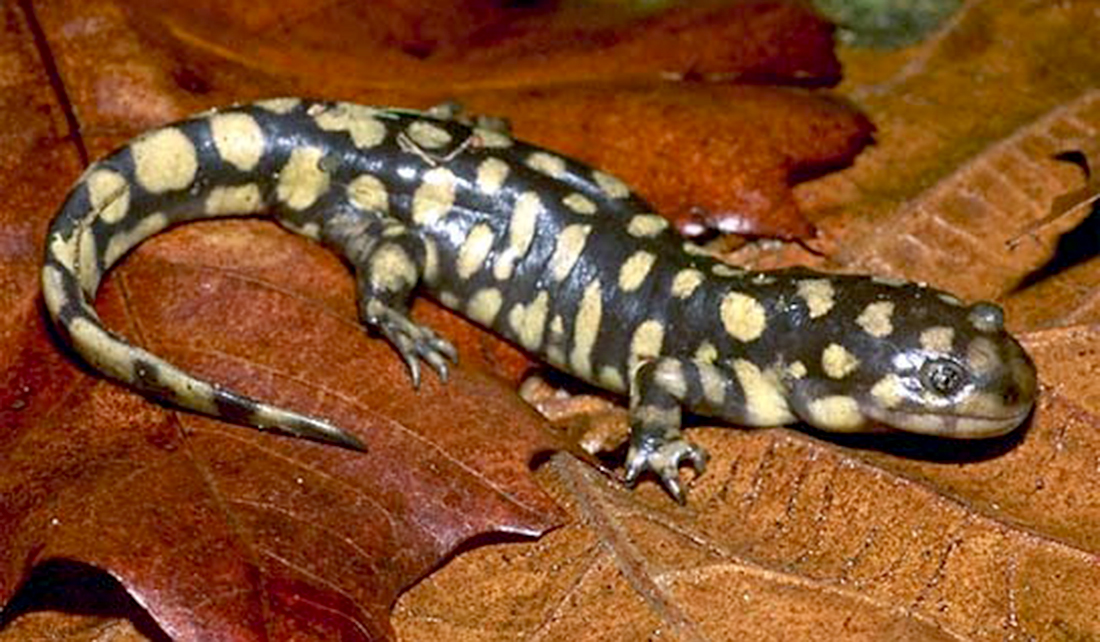
This is Illinois is a series focusing on wildlife and waterways found in Illinois. The stories are created in conjunction with the Illinois Water Resources Center.
Voted as the state amphibian in 2005, the eastern tiger salamander is one of 20 species of salamanders found throughout Illinois. As the largest land dwelling salamander in North America, eastern tiger salamanders range in size from 6 to 13 inches. In the wild, salamanders have lived to be 16 years old. Not only are they the largest, but they also have the greatest range of all salamanders, spreading from southeastern Alaska, across the width of the United States and all the way down to the Mexican Plateau. Forests, grasslands, or mashes are common places to find them.
But you might have to look hard, because these salamanders hide beneath rocks and stumps, and burrows up to two feet deep. Sometimes referred to as a mole salamander, this nocturnal species spends the majority of its life in cool, dark places, preferring to dig its own burrows to escape warm temperatures. The best time to see salamanders out in the open is after a rain, at night, or during mating season.
The mating season for tiger salamanders begins in late winter or early spring when the ground begins to thaw. Thawing creates temporary ponds of water, where salamanders migrate to mate. One to two days after courtship, females lay up to 1,000 jelly-like eggs on twigs, leaves, or grass on the bottom of the pond. After hatching, the larvae stay in the pond until two to five months old. Once fully grown, eastern tiger salamanders begin to show the unique markings that earned them their name. The most common marking combination is a black background spotted by yellow or gold. Other possibilities are barred, which have vertical yellow stripes running down the body, as well as blotched, which have irregular markings all around their back.
Although their black and yellow markings act as a warning sign to potential predators, not all animals are scared away so easily. Owls, snakes, badgers, and bobcats are common predators of full-grown salamanders while aquatic insects, and snakes eat the larvae. To further aid in defense against threats, salamanders curl their bodies, close their eyes, and wave their tail high above their lowered head. A sticky, poisonous secretion is then released from their skin, often times flung by the salamander’s tail onto the predator’s face. If done effectively, the predator will retreat—at the minimum—with a burning sensation in its eyes and nose.
Skin plays an essential role in every tiger salamander’s survival. Not only does skin ward off predators by secreting poisons, it is also the site of respiration. To ensure that oxygen and carbon dioxide can be exchanged, mucus is secreted by glands to keep the skin moist. Glands also release chemicals that coordinate mating behavior. Because the skin is such an important organ for salamanders, it is very sensitive to environmental changes. Acid rain, for example, has been known to kill them. After repeated contact from the rain, the high acidity damages the outer skin tissue, making it impossible for the salamander to breathe.
Other environmental changes that cause problems for salamanders include habitat loss, degradation, and fragmentation. Altering the land by channelizing streams, draining wetlands, and clearing forests have added to the reduction of habitat. Even removing temporary ponds causes a reduction in the population by destroying a breeding site or by killing the larvae, depending on the time of year.
In Illinois specifically, the majority of species have a gilled, aquatic, or larval stage when high quality water sources are required. Ensuring that salamanders have access to high quality land and water, large enough to sustain a diverse population, is essential to the survival of this amphibian.
In turn, tiger salamanders eat slugs, worms, snails, and insects while their larvae eat small crustaceans, insect larvae, and tadpoles.
Illinois-Indiana Sea Grant is a part of University of Illinois Extension and Purdue Extension.

